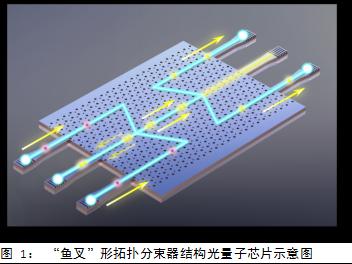Research team, led by academician GUO Guangcan from University of Science and Technology of China (USTC) of the Chinese Academy of Sciences (CAS), collaborating with researchers from Sun Yat-sen University and Zhejiang University, realized two-photon quantum interference in the structure of valley-dependent topological insulators based on the valley Hall effect.
The study was published in Physical Review Letters on June 11st, 2021.
Topological photonics has a practical application prospect in the research of photonic chips due to its robust energy transport prosperities. The key to topological phase transition is to generate an energy gap at certain degenerate points by breaking either the time-reversal symmetry (TRS) or inversion symmetry.
By breaking the spatial inversion symmetry of the system, the valley-dependent helical edge states travel in certain directions, which is known as Valley-Hall effect. Hexagonal lattice photonic crystals (PCs) with inequivalent sublattices can realize the valley-dependent topological insulators. More compact and sharp bending optical circuit can be realized, which contributes to device integration and robust energy.
In recent years, robust quantum state transfer in topology has been a hot research. Yet as the core of photonic quantum information, quantum interference remains to be verified in topologically protected PCs chip.
Researchers designed and fabricated harpoon-shaped beam splitters (HSBSs) in silicon photonic crystals. The orientation of the electromagnetic phase vortex inside PCs with hexagonal lattice structure depends on lattice structure with different topological Chern numbers and its band position, thereby to form two topological edges of different structures.
Based on a 120-deg-bending interfaces, they realized on-chip Hong-Ou-Mandel (HOM) interference in one HSBS with a high visibility of 95.6%. Furthermore, the generation of path-entangled state in valley-dependent quantum circuits is demonstrated by cascading two HSBSs.
The study provides a novel method for topological photonics, especially topological insulators, to be applied in more complex quantum information processing. Reviewers agreed that the research is interesting and important, and highly praised that “This is an interesting and important work. I find the results interesting, in particular, the implementation of the Hong-Ou-Mande effect in this device, which may have implications in high fidelity on-chip quantum information processing.”
###
Media Contact
Jane FAN Qiong
[email protected]
Related Journal Article
http://dx.





